How to crowdfund your marketplace
Your marketplace startup funding options aren’t limited to bootstrapping or raising venture capital. Read on for our CEO Juho’s best tips on a funding method close to all our hearts at Sharetribe: crowdfunding.
Published on
Last updated on

The previous two articles in this series on marketplace funding were dedicated to venture capital, where funding comes from a small number of wealthy institutions. Crowdfunding reverses the approach. In crowdfunding, a large number of individuals or organizations all invest small sums in your startup.
This startup funding approach is close to every Sharetriber’s heart: in 2018, we completed a crowfunding campaign that exceeded all our expectations.
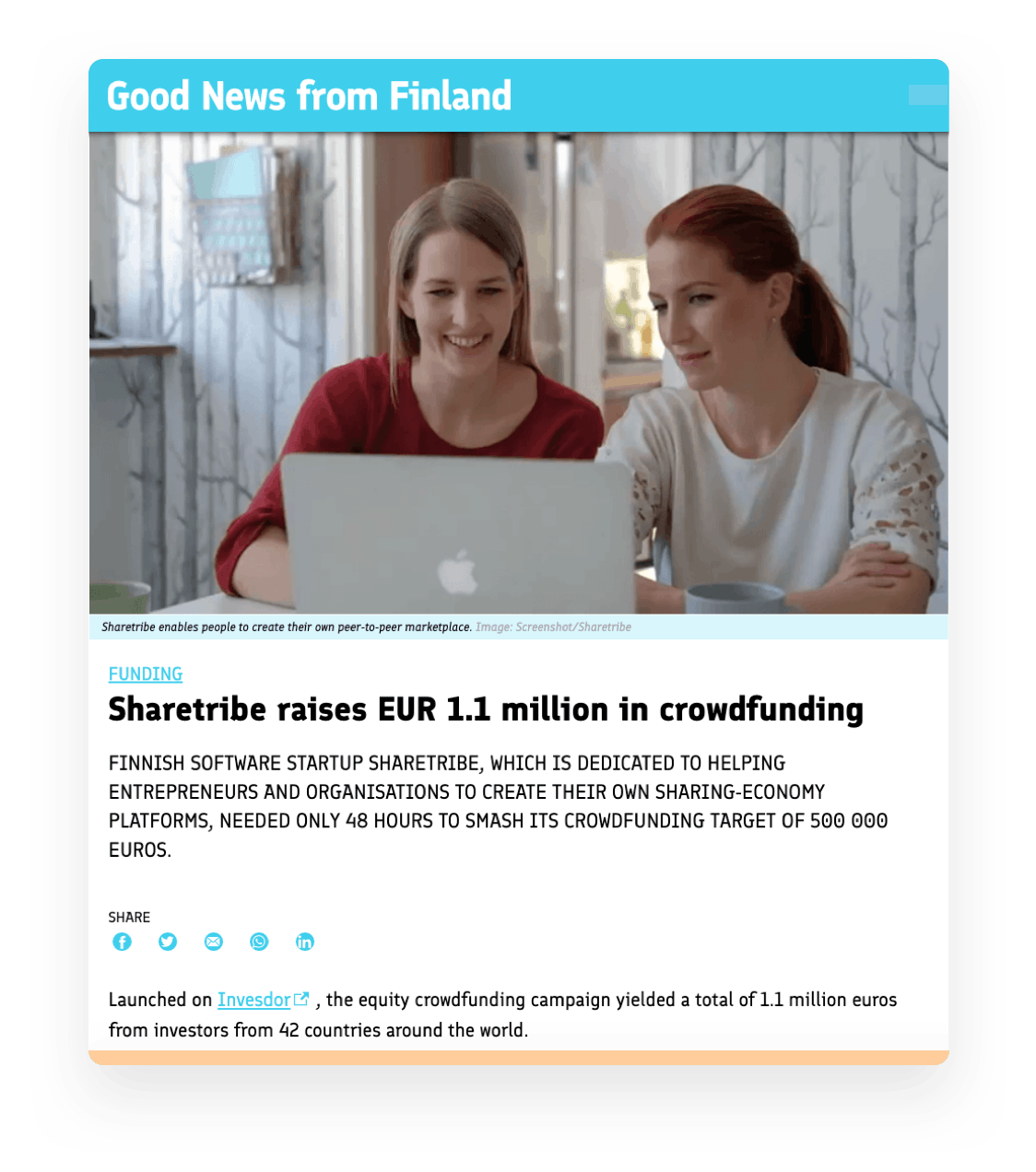
In this article, I’ll share what I’ve learned about crowdfunding, both from leading Sharetribe’s campaign and from working with marketplace startups for over a decade. I’ll look at
- How crowdfunding works
- The pros and cons of crowdfunding a marketplace
- the best strategies for successful crowdfunding.
My goal is to help you decide if crowdfunding could work for your marketplace and to maximize the potential of your crowdfunding campaign.
The term crowdfunding was popularized by marketplaces like Kickstarter and Indiegogo. They let people pre-sell a new product: work of art, board game, gadget; you name it. The pre-sale campaign funds product development and the pre-buyers are the first to get the new product.
(If you’re interested in Kickstarter’s story, check out our marketplace podcast episode with co-founder Charles Adler!)
Kickstarter and Indiegogo focus on reward-based crowdfunding. The approach is great for founders with a fascinating new product, and it can also work for non-profits that can offer more abstract tokens of gratitude as a reward. Ghost, a non-profit media publishing SaaS platform, crowdfunded this way successfully.
The approach rarely works for marketplaces that don’t have a product to pre-sell. Pre-selling subscriptions on a subscription-based marketplace could be an exception. I’ve never seen a marketplace doing this, though.
More typically, marketplaces fund through equity-based crowdfunding.
In equity-based crowdfunding, investors get a share in your company, just like angel investors or venture capitalists would. Equity crowdfunding is becoming more and more popular as a startup funding option.
Recently, cryptocurrencies have introduced a further crowdfunding option. Initial coin offering (ICO) means that a company creates a new cryptocurrency token, which buyers purchase in the hopes that its value increases. The founders’ ownership isn’t diluted as they don’t need to give up equity.
Several companies attempted something like this during the ICO boom that began in 2017. None of them has received significant traction so far, and most have wound down. I can only recommend the ICO route if creating a new cryptocurrency token is a part of your vision for other reasons as well.
The rest of this article will focus on equity-based crowdfunding. First, I’ll look at reasons to crowdfund and reasons not to.
Like any form of fundraising, crowdfunding comes with pros and cons you should consider.

A sweet spot for equity crowdfunding are companies that have a consumer-facing product and a community around it. This applies to most marketplaces, especially peer-to-peer ones.
If you already have a base of active, dedicated users, many of them might be interested in investing. They may believe in your idea and its potential to generate great returns, or they could simply want to support you. As investors, they might also continue to be even more loyal users of your platform.
Even if many people in your community won’t invest, it’s possible they’re open to help by spreading the word about your campaign.
A crowdfunding campaign will likely generate lots of buzz around your marketplace. In addition to attracting potential investors, it might help you find potential users, get coverage from journalists and bloggers, and catch the attention of potential employees and partners.
In a crowdfunding campaign, you might succeed in raising funding from hundreds or even thousands of individuals. All of them have made a significant commitment, which means they are now in your corner, invested in your success.
This community is valuable when you need help, whether in finding a new team member, spreading the word about a launch, or getting an introduction to a potential partner.
As we observed in an earlier article, venture capital funding is not for every marketplace. If yours is one of them, you need to find alternative sources of financing.
Crowdfunding has been used successfully by many marketplaces that are structured as platform cooperatives. A great example is Sharetribe customer Signalise, a marketplace for booking signal language interpreters. The platform is structured as a cooperative owned by the interpreters. It funded its early operations by raising nearly $500k in crowdfunding using community shares (also called withdrawable shares), which give each investor a membership status and exactly one vote in the cooperative, no matter how much money they invested.
Individuals that participate in crowdfunding do it for a variety of motivations. Some think like angel investors and want to maximize their returns, while others might simply want to show their support to certain initiatives by chipping in a small sum. This makes crowdfunding particularly well suited for marketplaces that focus on a social mission.
While crowdfunding offers many benefits, it's no walk in the park. In fact, a typical crowdfunding campaign might take a lot more work than other ways of fundraising. In addition to marketing and promoting the campaign, you typically need to first conduct a more traditional fundraising effort to "seed" your campaign.
Not all crowdfunding campaigns succeed. For example, Kickstarter's success rate is just under 40%. Most equity crowdfunding platforms don't publish their success rates, but it's likely they're seeing something comparable.
Naturally, you might also fail in your attempts to raise angel or venture funding. However, failing in your crowdfunding campaign is a more public failure: everyone who saw your campaign will know you didn't succeed. This might make some of them doubt the viability of your business, which can damage your reputation.
As we noted in the previous article, a successful marketplace VC funding round brings in "smart money": in addition to the capital, your investors should be able to provide advice and connections. A VC typically takes a seat on your board and spends a lot of their time helping you succeed. This can be tremendously valuable.
When you crowdfund, the pool of potential supporters is a lot bigger, but they are all a lot less invested. You might be able to get an hour of their time every now and then, but that's probably the maximum.
Some countries have put regulatory restrictions on the amounts you can raise with crowdfunding. For example, in the US the current limit on crowdfunding is 5 million US dollars.
Even if without legal restrictions, there are usually practical limits to how much you can expect to raise this way. Eight-figure rounds are rare and in practice only work for well-known brands. Nobody has managed to raise a hundred million or more.
Meanwhile, in venture capital, rounds north of a billion dollars are not uncommon. Thus, the feasibility of crowdfunding depends on your marketplace’s business stage and capital needs.
After careful consideration, you've come to the conclusion that you want to proceed with crowdfunding. Great! Now, let's look at tactics for succeeding with your campaign.
Crowdfunding often works best with an existing community. This is great for marketplaces that are already in business, but if you’re not, it can be tricky to succeed in your campaign. Thus, in most scenarios, crowdfunding is not a viable alternative to fund the development of your minimum viable platform. There are some exceptions, which mostly combine great storytelling and marketing skills with a strong team, a track record of startup success, and a large existing network.
In most scenarios, though, my recommendation is to bootstrap your marketplace until you've proven the problem/solution fit at least.
Sharetribe customer The Octopus Club, a marketplace for pre-owned children's products, used this very strategy. Founder Ana Rachel Estrougo bootstrapped and used her own network, connections, and social media to get to her first two thousand members. This initial community proved to the investors that the concept had potential. Many of the first users also ended up becoming investors themselves. The Octopus Club raised nearly $200k via Crowdcube in the summer of 2021.
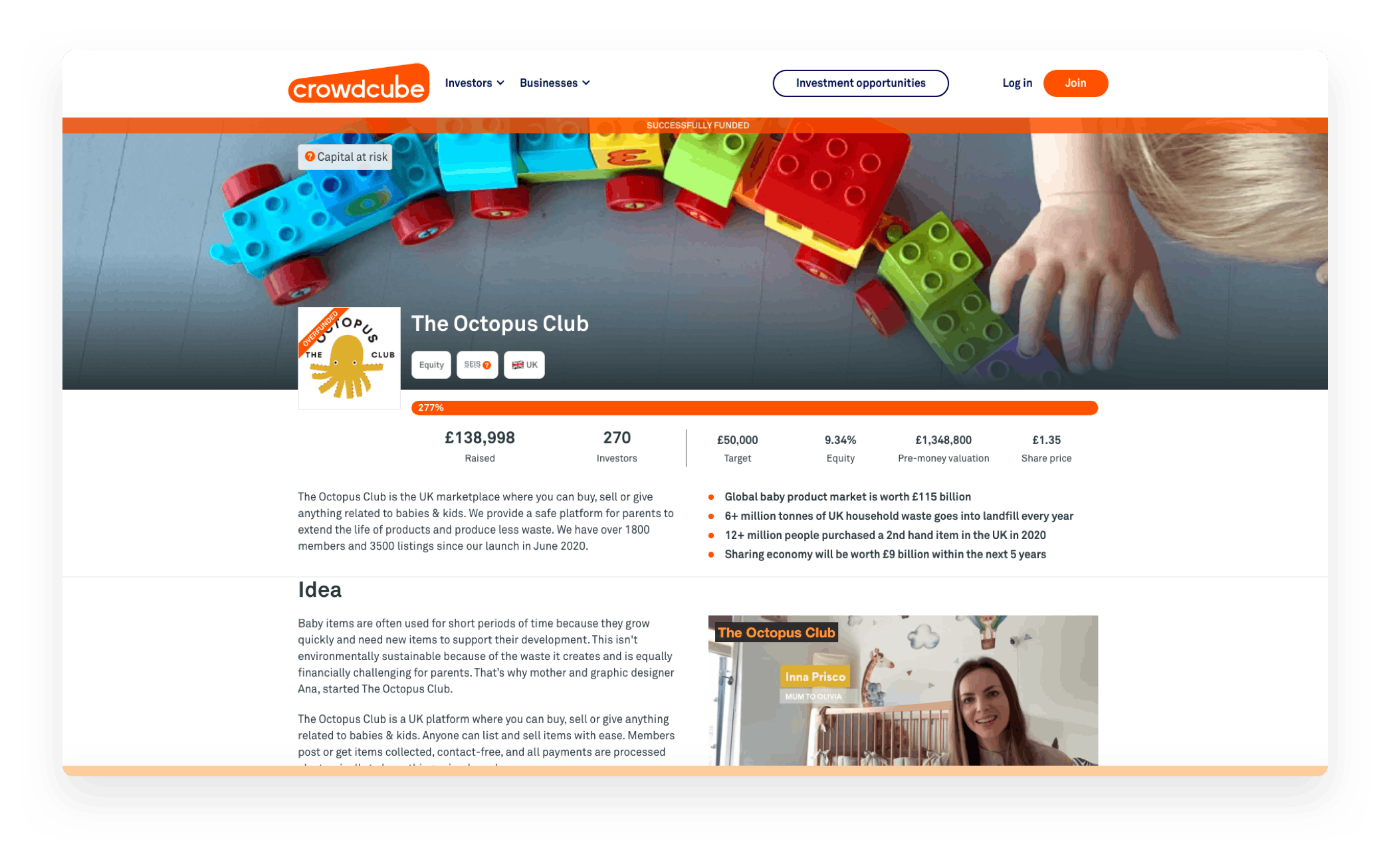
An additional benefit of crowdfunding for a live product is you get the most out of your marketing campaign. Many people who first learn about your marketplace through your crowdfunding might become active users in addition to investors. As you've already proven that your initial concept works, the investment in marketing is more likely to provide returns.
In equity crowdfunding, you typically need to specify a minimum sum you need to raise for the campaign to succeed. If you raise less than the minimum, you won't get anything: all the money you raised will be returned to the investors.
It's usually a good idea to put the minimum threshold relatively low and set a maximum target that is a lot higher. You don't want to set it too high, though. Just like VC funding, equity crowdfunding will dilute your ownership, so you shouldn't give up more than you need.
The minimum also shouldn't be too low. You need to ensure you have a clear path of hitting your next business milestone even if you only get the minimum. The excitement around crowdfunding campaigns tends to wane after the minimum has been reached as people think you have met your goal.
In addition to the size of the funding round, you also need to specify the minimum size of an investment. Here, again, you need to find the balance. Many will choose the minimum sum, no matter what it is, so you don't want to make it too low. At the same time, a high minimum investment can be a barrier to entry. Your crowdfunding platform can typically provide some guidance here, but in addition to that, you should understand your target investor demographic well.
A further important parameter is the length of your campaign. An equity crowdfunding campaign has a clear start and end date. From the outset, it might seem that a longer period will maximize your chances of succeeding. This is not always the case. A long campaign can lose momentum midway through, while a shorter one can keep the hype going with new investments coming in every day.
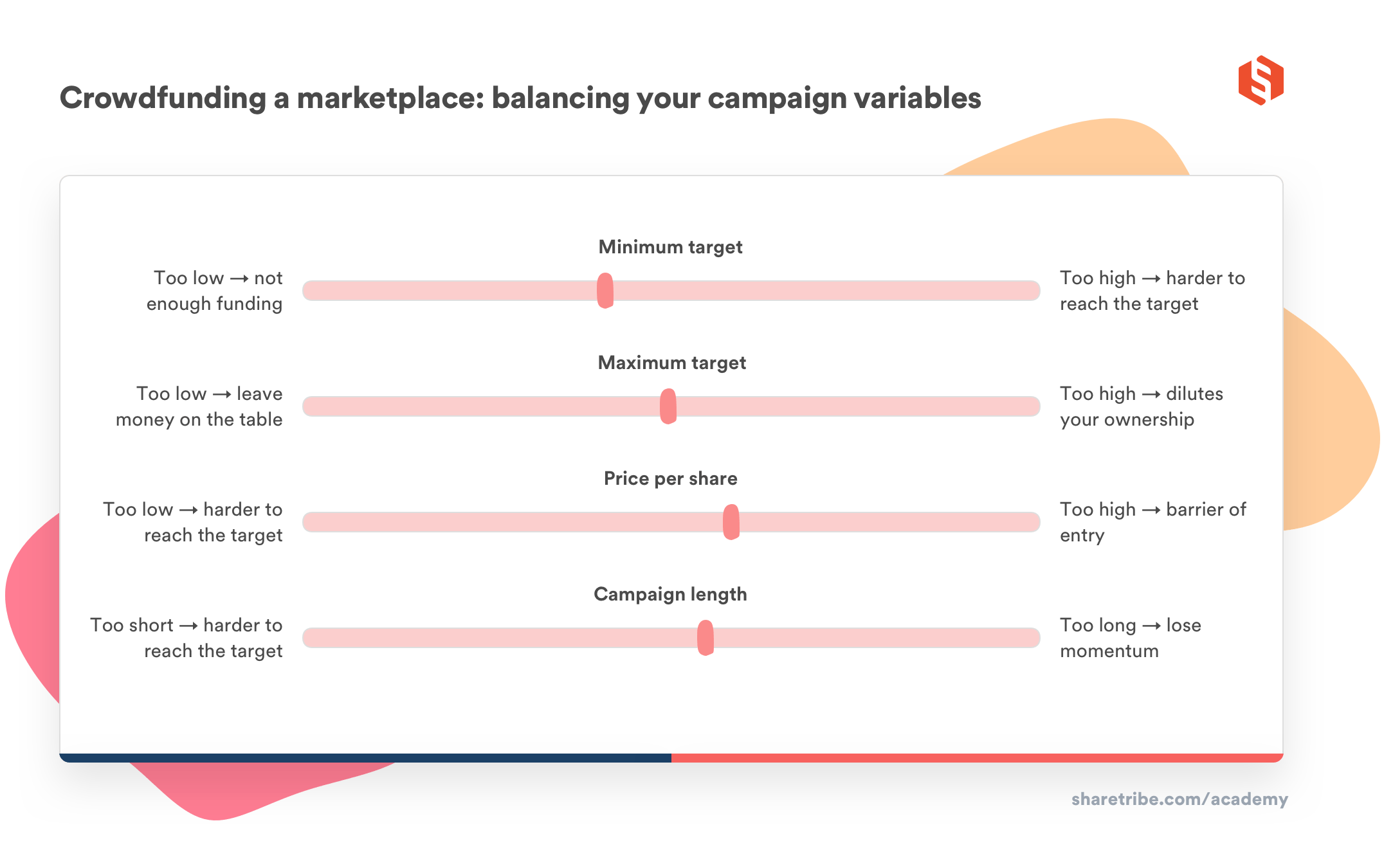
Many equity crowdfunding platforms require you to raise a minimum sum before you can launch your campaign publicly. The requirement is typically around 30% of your minimum funding target. The platforms have learned that businesses that fail to meet this minimum threshold often don't end up succeeding with their campaigns.
The seed requirement often means that a crowdfunding campaign is preceded by traditional fundraising. One option is to approach local angel investors, and in some cases, even early-stage venture capital firms to get them to "seed" your round by committing to putting in at least the minimum.
Sharetribe customer Cycle.land, a marketplace for peer-to-peer bike rentals, successfully raised more than $500k in its first equity crowdfunding campaign. Founder Agnel Milukaite observes:
"As a startup, you still have to put in the effort to excite the investors about your company’s potential. This work starts well ahead of the launch of the campaign. When you launch, you will want to have pledges from a sufficient number of investors to be confident about the success of the campaign."

At Sharetribe, we started a traditional fundraising process in January, even though our campaign was set to go live only in April. From January to March, we talked to a large number of potential investors and got pre-commitments from many. These initial commitments gave the campaign momentum when it was launched.
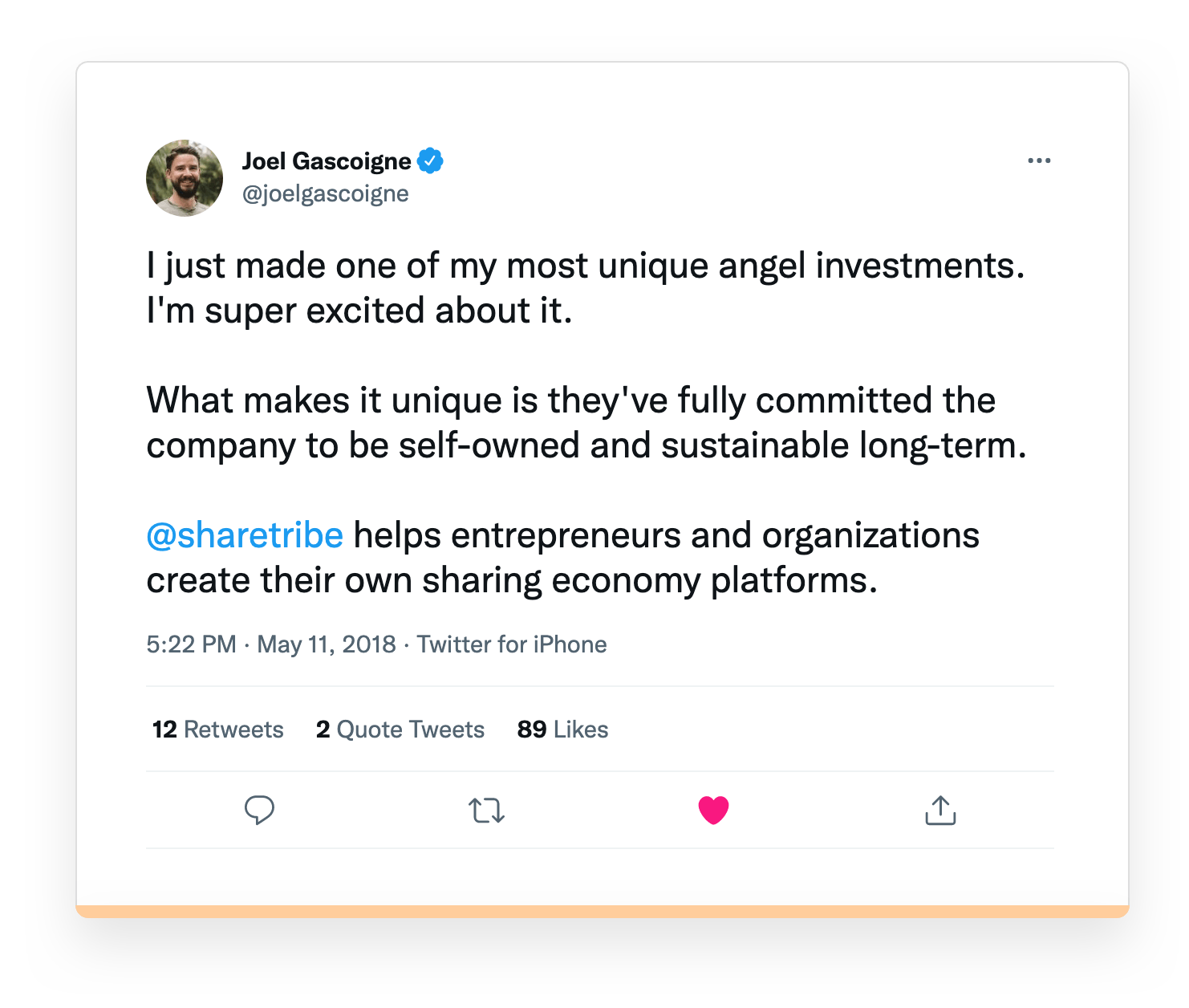
It's also a good idea to prepare your community for the fundraising campaign.
Peerby, a Dutch peer-to-peer rental marketplace organized "pitching events" for its community members to ask questions from founder Daan Weddepohl. Early contacts with the community let Peerby ensure several people were ready to commit to investing at the time of the campaign launch. As a result, Peerby’s campaign was a success, with more than 1,000 people investing in more than $2 million.
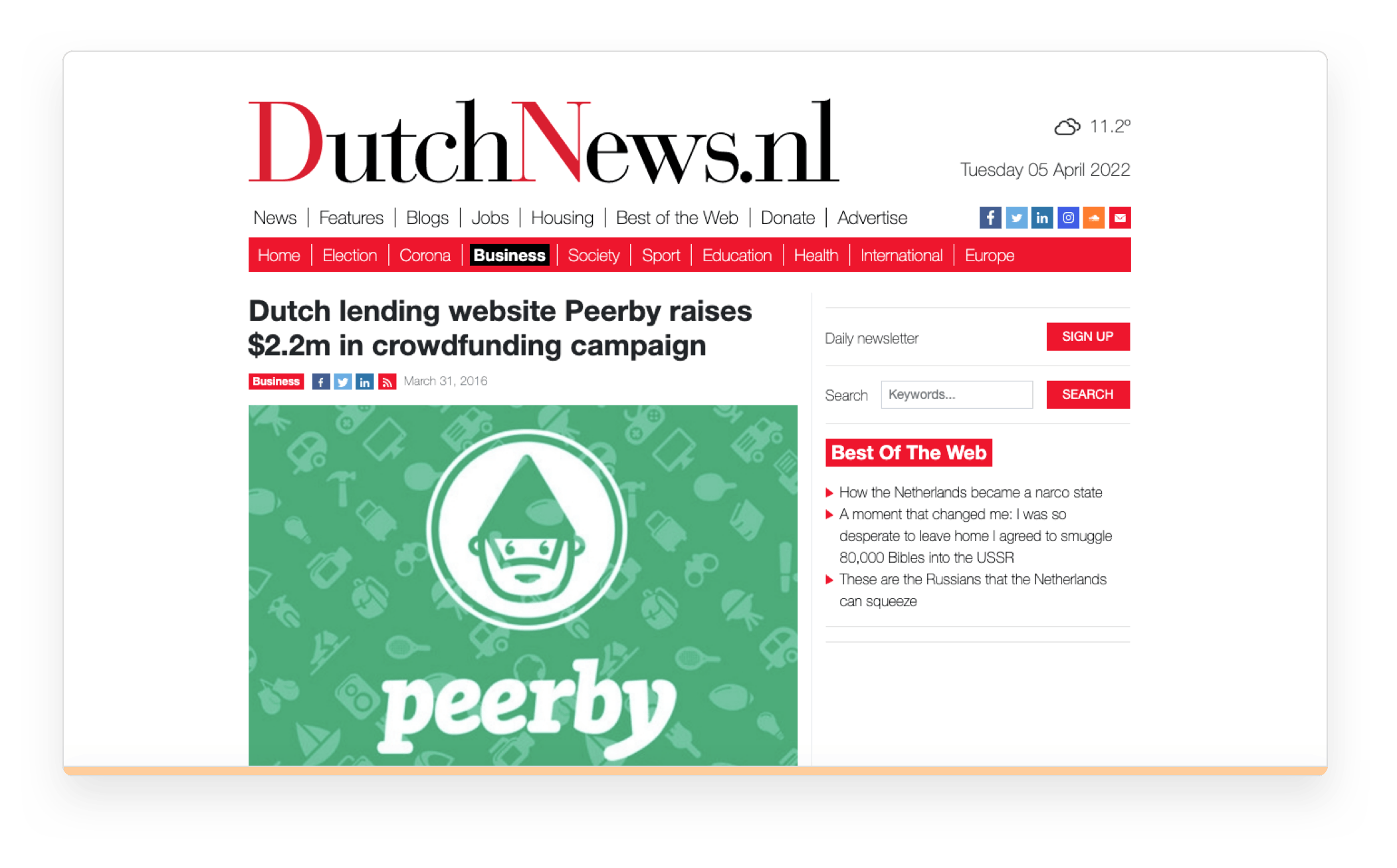
Weddepohl observes: "In traditional fundraising, what matters are your current metrics. In equity crowdfunding, what matters is the reputation you've built over the years with your community."
At Sharetribe, we sent a survey to everyone on our mailing list two months before launching the campaign. We asked people directly if they would be interested in participating, and, if yes, how much they’d be willing to invest. In total, 500 people expressed their interest, which for us was a strong sign that we should pursue the campaign. Naturally, these commitments aren’t set in stone. Not everyone from our pre-commitment list invested, but more than 100 people did.
Your community can also help amplify your message. It's a good idea to ask your community members to share the fundraising announcement. Let them know that sharing is an easy, free way to support your campaign.
A great story is a large part of any fundraising effort. Its importance is even greater in equity crowdfunding, where you need to convince a large number of individuals about your marketplace’s potential.
Navisyo, the "Airbnb of the seas", mastered this approach. The team brought in over 1,000 investors from over 50 countries around the world and raised over a million dollars in its first equity crowdfunding campaign. In the campaign message, Navisyo emphasized its market opportunity, innovative approach, social mission, and its model to funnel proceeds back into the community.
Telling your story through a high-quality video has become an industry standard in the world of crowdfunding. Consider featuring the founders addressing potential investors directly. Authenticity matters more than professionalism, in my experience.
Everyone who joins your crowdfunding campaign makes a big commitment. They are now in your corner and want to help you succeed.
Committed early investors are a big advantage. Encourage them to spread the word about your campaign. Many might have vast networks of other potential investors.
Navisyo used this strategy successfully through a program called "direct straight referral". The program gave early investors a commission on each investment that came in through their referral. This created an even stronger incentive to share the news about the campaign.
It’s also a good idea to keep connecting with investors throughout the campaign. At Sharetribe, we saw several people invest two or even three times as the campaign became more and more successful.
Don’t let interest in your campaign die down after the first days. Many potential investor are monitoring your progress closely. If a week goes by without additional investments, they might consider the campaign doomed. You want to ensure a regular stream of new investments throughout the campaign.
A clear marketing plan for the duration of the campaign helps.
At Sharetribe, we shared a new piece of content each day of our campaign: interviews with customers or team members, blog posts about our mission, press articles we were featured in (we were constantly working on PR to produce mentions of our campaign in online publications), and so on. You can also time interesting product or partnership releases to happen during the campaign. Give your ambassadors something to share every day.
Crowdfunding milestones are also worth celebrating. Take advantage of crossing a rounded figure, getting your first 100 investors, or hitting your minimum target. Crowdfunding runs on social proof: the more people invest, the more attractive your campaign becomes.
The last couple days of the campaign are critical. This is a moment where another surge of interest is possible. Make sure every potential investor is made aware it's their last opportunity to act. Start reminding them a couple days in advance and continue up until the last moment.
Crowdfunding can be a great way to fund a marketplace. Especially if you've already managed to build a strong initial community and have an exciting social mission, you have the chance to engage people around your marketplace with a great story.
Building a successful crowdfunding campaign is hard work, so it's important to prepare well in advance and ensure you make the most out of it as a marketing campaign as well.
Equity crowdfunding and raising funding from venture capitalists or angel investors all require giving up a percentage of your company in exchange for capital. In many cases, this is either not possible or desirable.
Thus, in the next and final article of this series, I'll take a deeper look at several non-dilutive funding options for marketplace companies: loans, grants, and revenue-based financing.
You might also like...

Marketplace funding: The complete guide
Struggling with funding your marketplace? This guide helps you decide how much marketplace funding you need – and when and where to source it.

From marketplace idea to profitability in a matter of months
An interview with the founders of Cycle.land, the Sharetribe-powered bike-sharing marketplace that raised more than £400,000 in equity crowdfunding.

How to use PR to grow your online marketplace business
Learn how to transform your sharing economy business with PR, and get a free professional press release template.
Start your 14-day free trial
Create a marketplace today!
- Launch quickly, without coding
- Extend infinitely
- Scale to any size
No credit card required
